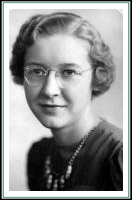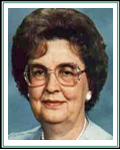
One of the key roadblocks to
further education in the early 20th century was transportation. The high
schools in the area were located in towns and would require
rural students to find their own way into town each day to attend. Economics
and the busy schedules of farmers made this a very difficult
trick to manage. Plus, in those days, boys were expected to help
out on the home farm or to find some type of employment with
local farmers. So, attending through 8th grade was
considered enough education.
Sometime in the late 1940s, several
small one-room school districts include Bridge School,
consolidated into what is now called Dundee Community Schools
whose nickname is the Vikings. With the advent of reliable bus transportation, it was
more efficient to provide schooling at one location for large
numbers of students.

 Of the 13 children of
William
Carl and Mary (Rambow) Heiden, only the youngest two,
Wilma (Heiden) Bicking
(left) and
Norma "Jeanie" Heiden
(right) attended Dundee High School. Norma, in fact, was the Salutatorian
of her graduating class. All of the other children attended
Bridge School through the
8th grade.
Of the 13 children of
William
Carl and Mary (Rambow) Heiden, only the youngest two,
Wilma (Heiden) Bicking
(left) and
Norma "Jeanie" Heiden
(right) attended Dundee High School. Norma, in fact, was the Salutatorian
of her graduating class. All of the other children attended
Bridge School through the
8th grade.
In the post-WWII years, many,
many children of the Heiden family attended community school in
Dundee or Ida. Many of
them in Dundee started in kindergarten at the far east end of the
large building
and continued through high school west end of the building shown above.
One picture included in the high school yearbook was one showing
those who had attended all 13 years together in this one
building.
With the onslaught of
the large baby boom generation, schools all over the country
were expanded to accommodate the increased enrollments.
Dundee was part of this trend and the author was part of one
of the first classes to go from kindergarten the east end of
the old building to graduate from the new addition in 1966.
Since that time, DHS has built an entirely separate, new
high school across the street.

